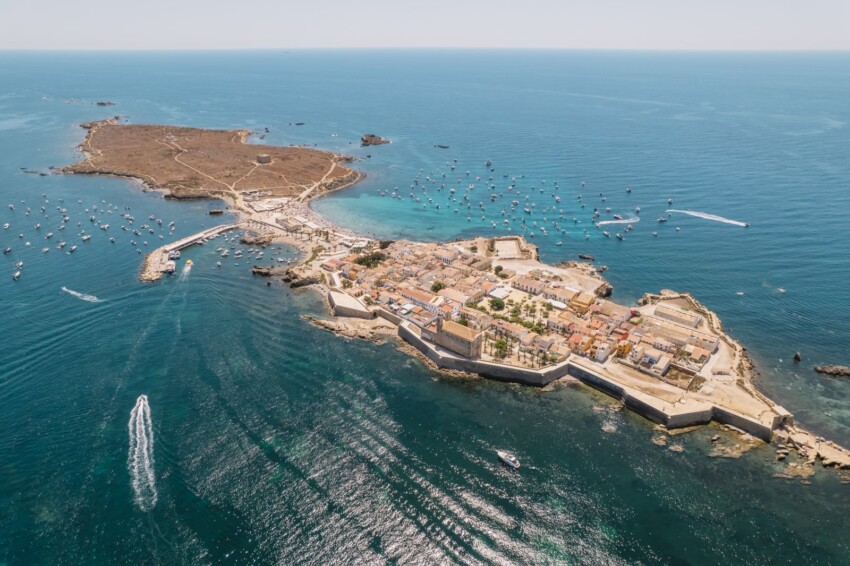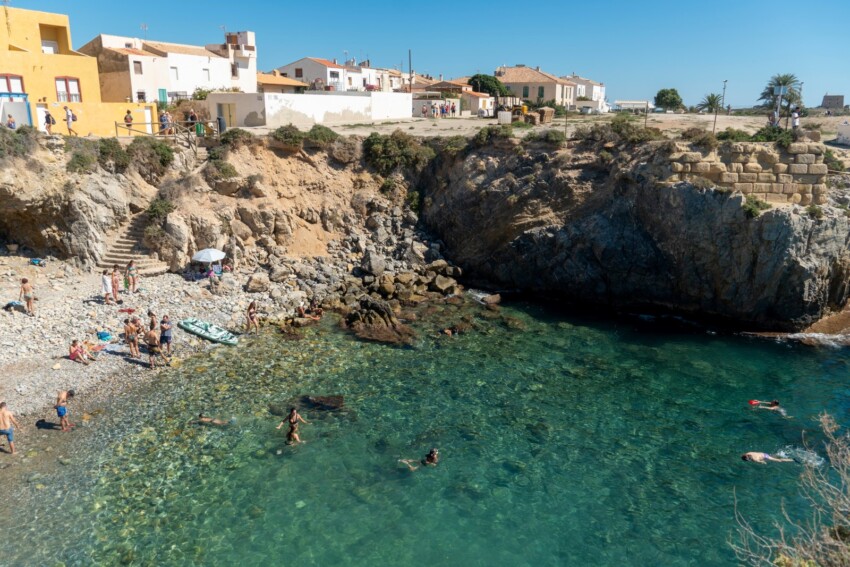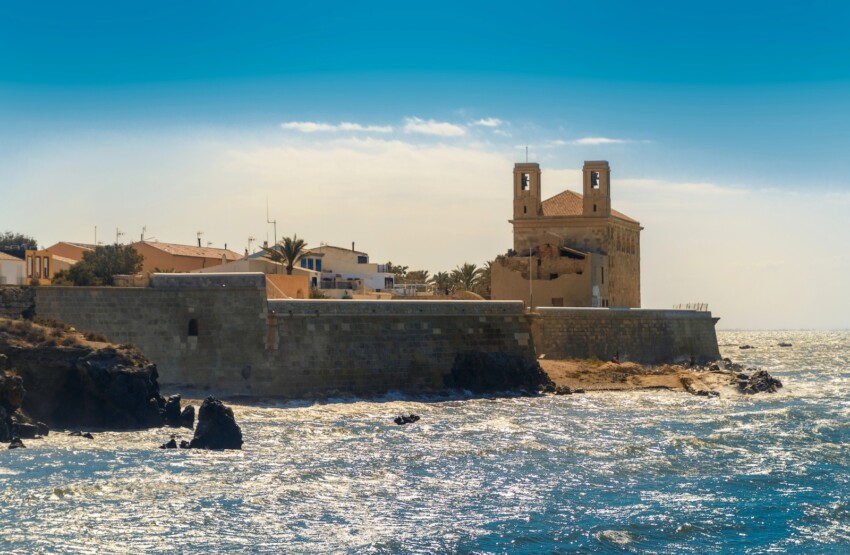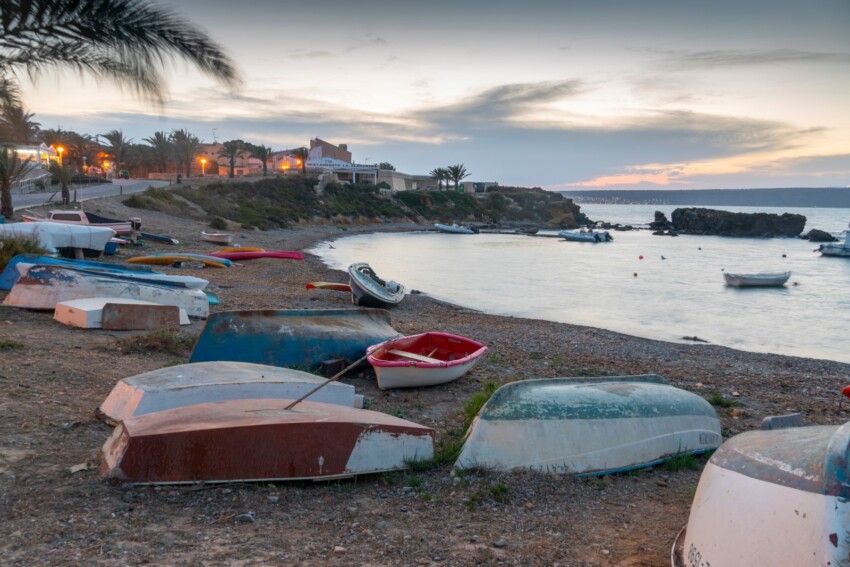

Leave the city of Alicante for a day and dive into an even bluer world: Tabarca Island is a small paradise on earth just 20 km off the city.
The only inhabited island in the Valencian Community, with a population of only a few dozen people in winter, Tabarca Island comes alive in summer.
It is the perfect destination for a wonderful day trip from Alicante and an absolute must for snorkelling enthusiasts.
The island’s waters are part of a nature reserve and are protected for their excellent quality and biodiversity of flora and fauna. Tabarca’s small beaches and coves are wonderful for spending a day in nature.
For moments of movie romance, stop by in the evening, when everyone else has already left. The island quiets down and the sound of the sea becomes the soundtrack of your holiday.
Don’t leave the island without tasting Tabarca ‘s typical dish, the caldero tabarquino, a delicious fish stew (caldero means ‘pot’ in Spanish).

Although the island is very small, there is enough to do to fill a whole day.
Many tourists come to the island of Tabarca to spend the whole day at the beach, basking in the sun and diving into the island’s transparent waters, perfect for snorkelling.
This is indeed a very good idea: Tabarca has a good number of small beaches and coves, mostly rocky, and one can easily spend a day visiting a couple or more of them, stopping a few hours at each. Some beaches are equipped and a little more crowded, while others are more isolated.
If you are planning such an excursion and want to cut costs, bring a packed lunch.

Another option is a complete tour of the island. Start your daylong exploration with a walk to the lighthouse at the tip of the island. Along the way, observe the arid, almost desert-like vegetation with low bushes and cacti. You might easily spot birds of rare species lazily sunbathing along the coast.
When you reach the lighthouse, enjoy the beautiful view of the Mediterranean and then head back to the island town. Here you can visit the Baroque church of St Peter and Paul and the town museum, but the best experience is to wander aimlessly through the town’s narrow alleys and lanes: you won’t find it difficult to recognise the rigid geometric pattern that betrays its military origins.
At this point, you might want to stop for a snack in one of the island’s bars, almost all decorated with a pirate theme, after which you can enjoy a well-deserved rest on the beach.
After sunset, when the daily tourists have left the island, Tabarca becomes simply magical. Quiet and romantic, thoughtful and proud, it is the ideal place for those seeking peace, relaxation and emotions that touch the heart. It is not recommended, however, for those seeking nightlife.

The island of Tabarca thrives on tourism, so despite its small size you will find all the essential services available, whether for a day trip or a longer stay. There are a few hotels and room rentals on the island, as well as a good choice of bars and restaurants.
Staying a night or more on the island of Tabarca is certainly a fascinating experience, but due to the limited accommodation it is advisable to book well in advance.
We offer a selection of hotels at Tabarca Island to suit all categories of travellers. The most booked by tourists are the sea-facing hotels, often right on the beach. If you want to play it safe, choose one of the following: they are among the most booked hotels in Tabarca Island, sorted by number of reviews.
If you prefer space, privacy and the ability to prepare your own meals to a hotel holiday, book a holiday home at Tabarca Island. We recommend a few below, but in this case we advise you to book early because houses and apartments for rent at Tabarca Island are in high demand.
The easiest way to reach the island of Tabarca from Alicante is to take one of the tourist ferries that depart from the marina in the Paseo Tomás y Valiente. The crossing takes about an hour; times vary depending on the season.
You can also take the ferry to the island of Tabarca from Benidorm and Santa Pola.
Many tourists think that Tabarca is a single island, in reality it is part of a small archipelago that also includes the islets of La Cantera, La Galera and Nao.
The island has an elongated shape that narrows in half at the harbour and the main beach. On one side of this narrowing is ‘el poblado’, the urbanised area, and on the other is ‘el campo’, a larger area that still remains wild. The latter seen from above vaguely resembles a fish.
The island is less than three kilometres long and has a maximum width of 400 metres.
It is also called the Island of New Tabarca or Piana.
Historical evidence reveals that the lands of Tabarca hosted a refuge for Berber pirates in past centuries.
In the 18th century, Charles III ordered the fortification of the island and the construction of a small village where some families of fishermen of Genoese origin who had been held prisoner in the Tunisian town of Tabarka, escaped and were shipwrecked near the island, could take refuge.
In 1986, Tabarca Island was declared a nature reserve, making it Spain’s first marine reserve. The Reserva Marina de la Isla de Tabarca is also a sanctuary for the protection of endangered birds.
Tabarca is located a few kilometres from the Spanish coast, specifically Santa Pola, within the Comunidad Valenciana. It is about 20 kilometres from Alicante, as the crow flies.